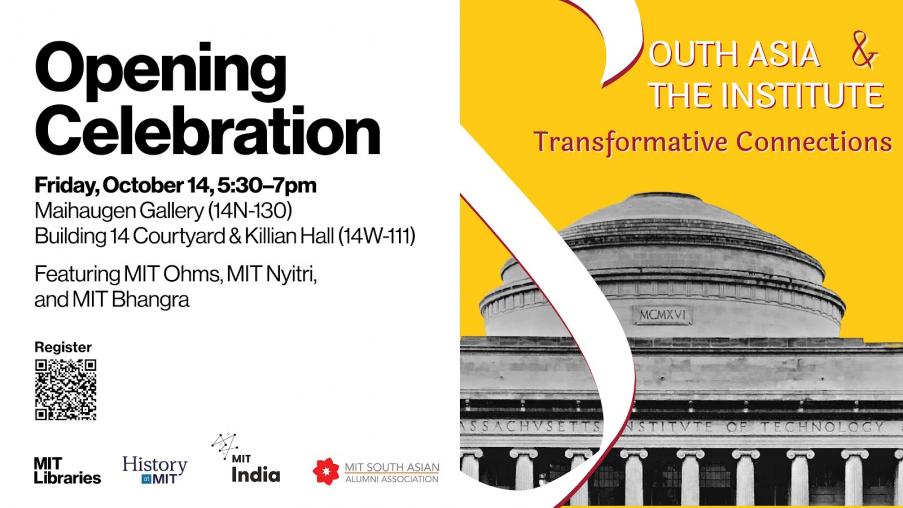Contribute
| Uncovering More Than A Century Of Connections Between South Asia And MIT |
10/07/2022
South Asia and the Institute: Transformative Connections, at MIT’s Maihaugen Gallery, opens on 14 October 2022 and will be at
the gallery for one year. Register here to attend the Opening Celebration
which will also feature performances by student groups Ohms, MIT Nritya, and
MIT Bhangra. Or here
to view the gallery after the opening. South Asia and the Institute: Transformational
Connections showcases the
longstanding connections between MIT and South Asia (India, Pakistan,
Bangladesh, Sri Lanka, Nepal) that go back more than 140 years. The Institute’s past and
present has been enriched as much by South Asian students and faculty as their
lives have been shaped by the Institute. Perched at the forefront of
technological revolutions across the globe, MIT’s South Asians have negotiated
a changing world of race and immigration in America, and decolonization and
nation-building in South Asia. South Asia and the Institute makes
these transformative connections visible. This exhibition is
part of a larger oral history project and digital archive led by Sana
Aiyar, Associate Professor,, History, MIT, Dr Ranu Boppanna '87, Past President, MIT
South Asian Alumni Association, and Nureen Das, Managing Director, MISTI India.
Since January 2021, more than 25 students have joined the team in a History Lab. They have done extensive research
digging into the Institute’s archival records at MIT’s Distinctive Collections
and have collected nearly 90 oral histories from alumni, staff, and faculty
at the Institute. For
background, the very first student from what was then British-ruled India
attended MIT in 1880, just two decades after the founding of the Institute. For
Indians aspiring to freedom, technical education and skills were the
need-of-the-hour to alleviate the poverty and underdevelopment facing their
country after more than a century of colonization. Then, as now, South Asians
looked to MIT as a model institute where they could acquire this knowledge.
After
independence in 1947, the Institute served as a guide and partner in the
challenging work of decolonization and nation-building that South Asians
embarked upon. At the same time, with the reform of discriminatory anti-Asian
US immigration policies in the mid-20th century, a growing diaspora of South
Asian Americans found a home in MIT. Since
then, thousands of MIT’s South Asian alumni, dozens of South Asian faculty, and
a large number of academics with a research interest in South Asia have been an
active and large presence in all five of MIT’s schools. “MIT
is an institution that is continually looking to the future, but in uncovering
its history, we learn much about ourselves,†says Dr Ranu Boppana ‘87. Rujul
Gandhi ‘22, saw connections between MIT and Boston’s international community,
noting, “MIT seemed to have a large concentration of international students, so
it became the hub of where people from different campuses would come to meet.†Researching history in
the MIT archives is like putting together a jigsaw puzzle, according to senior
Jupneet Singh. “You get a name from here, a picture from here†and you begin to
piece together stories about people from the past, says Singh, who dived into
the archives for class 21H.S04 (South Asian MIT Oral History and Digital
Archive), a special topic in history taught by Associate Professor Sana Aiyar. For Singh, whose
parents immigrated to the United States from India to provide “a better life to
their children,†this work is personally meaningful. “These are the people who
paved the way,†she says. “This is a story that’s
broader than just MIT,†Professor Sana Aiyar says. “The South Asian experience
at MIT becomes a lens by which we can explore and understand the historical
context of important contemporary issues such as race and immigration in
America and decolonization and nation-building in South Asia. Students in this
class — what I like to call the history lab — learn to historicize and
contextualize their archival research and the deeply personal individual oral
histories they conduct with alumni in multimedia class projects. They aren’t
just students of history — they get to be historians.†Media Contact- Nureen
Das, Managing Director, MISTI MIT-India ​​mit-india@mit.edu
You may also access this article through our web-site http://www.lokvani.com/
